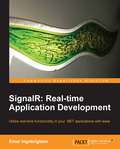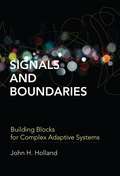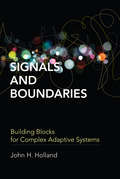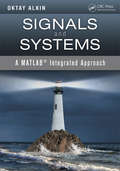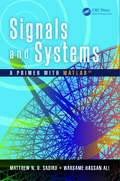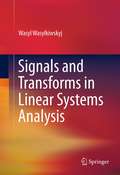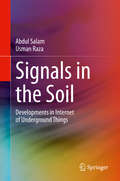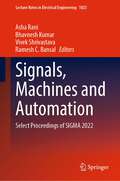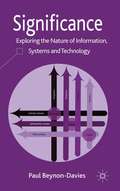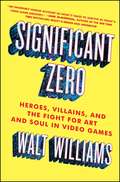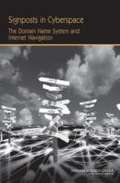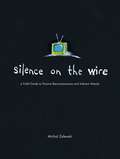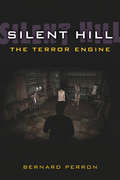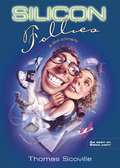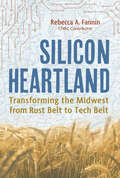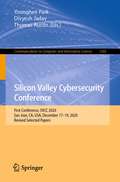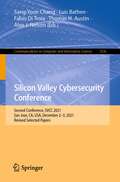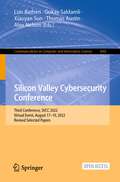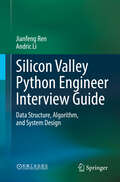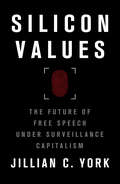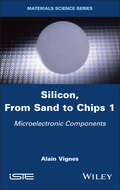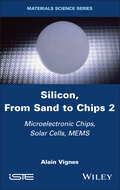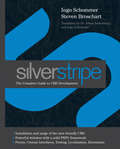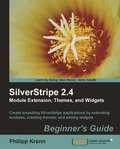- Table View
- List View
SignalR: Real-time Application Development
by Einar IngebrigtsenThis step-by-step guide gives you practical advice, tips, and tricks that will have you writing real-time apps quickly and easily.If you are a .NET developer who wants to be at the cutting edge of development, then this book is for you. Real-time application development is made simple in this guide, so as long as you have basic knowledge of .NET, a copy of Visual Studio, and NuGet installed, you are ready to go
Signals and Boundaries: Building Blocks for Complex Adaptive Systems
by John H. HollandComplex adaptive systems (cas), including ecosystems, governments, biological cells, and markets, are characterized by intricate hierarchical arrangements of boundaries and signals. In ecosystems, for example, niches act as semi-permeable boundaries, and smells and visual patterns serve as signals; governments have departmental hierarchies with memoranda acting as signals; and so it is with other cas. Despite a wealth of data and descriptions concerning different cas, there remain many unanswered questions about "steering" these systems. In Signals and Boundaries, John Holland argues that understanding the origin of the intricate signal/border hierarchies of these systems is the key to answering such questions. He develops an overarching framework for comparing and steering cas through the mechanisms that generate their signal/boundary hierarchies. Holland lays out a path for developing the framework that emphasizes agents, niches, theory, and mathematical models. He discusses, among other topics, theory construction; signal-processing agents; networks as representations of signal/boundary interaction; adaptation; recombination and reproduction; the use of tagged urn models (adapted from elementary probability theory) to represent boundary hierarchies; finitely generated systems as a way to tie the models examined into a single framework; the framework itself, illustrated by a simple finitely generated version of the development of a multi-celled organism; and Markov processes.
Signals and Boundaries: Building Blocks for Complex Adaptive Systems (The\mit Press Ser.)
by John H. HollandAn overarching framework for comparing and steering complex adaptive systems is developed through understanding the mechanisms that generate their intricate signal/boundary hierarchies.Complex adaptive systems (cas), including ecosystems, governments, biological cells, and markets, are characterized by intricate hierarchical arrangements of boundaries and signals. In ecosystems, for example, niches act as semi-permeable boundaries, and smells and visual patterns serve as signals; governments have departmental hierarchies with memoranda acting as signals; and so it is with other cas. Despite a wealth of data and descriptions concerning different cas, there remain many unanswered questions about "steering" these systems. In Signals and Boundaries, John Holland argues that understanding the origin of the intricate signal/border hierarchies of these systems is the key to answering such questions. He develops an overarching framework for comparing and steering cas through the mechanisms that generate their signal/boundary hierarchies.Holland lays out a path for developing the framework that emphasizes agents, niches, theory, and mathematical models. He discusses, among other topics, theory construction; signal-processing agents; networks as representations of signal/boundary interaction; adaptation; recombination and reproduction; the use of tagged urn models (adapted from elementary probability theory) to represent boundary hierarchies; finitely generated systems as a way to tie the models examined into a single framework; the framework itself, illustrated by a simple finitely generated version of the development of a multi-celled organism; and Markov processes.
Signals and Systems: A MATLAB Integrated Approach
by Oktay AlkinDrawing on the author's 25+ years of teaching experience, Signals and Systems: A MATLAB Integrated Approach presents a novel and comprehensive approach to understanding signals and systems theory. Many texts use MATLAB as a computational tool, but Alkin's text employs MATLAB both computationally and pedagogically to provide interactive, visual rein
Signals and Systems: A Primer with MATLAB
by Matthew N. Sadiku Warsame Hassan AliSignals and Systems: A Primer with MATLAB provides clear, interesting, and easy-to-understand coverage of continuous-time and discrete-time signals and systems. Each chapter opens with a historical profile or career talk, followed by an introduction that states the chapter objectives and links the chapter to the previous ones. All principles are pr
Signals and Transforms in Linear Systems Analysis
by Wasyl WasylkiwskyjSignals and Transforms in Linear Systems Analysis covers the subject of signals and transforms, particularly in the context of linear systems theory. Chapter 2 provides the theoretical background for the remainder of the text. Chapter 3 treats Fourier series and integrals. Particular attention is paid to convergence properties at step discontinuities. This includes the Gibbs phenomenon and its amelioration via the Fejer summation techniques. Special topics include modulation and analytic signal representation, Fourier transforms and analytic function theory, time-frequency analysis and frequency dispersion. Fundamentals of linear system theory for LTI analogue systems, with a brief account of time-varying systems, are covered in Chapter 4 . Discrete systems are covered in Chapters 6 and 7. The Laplace transform treatment in Chapter 5 relies heavily on analytic function theory as does Chapter 8 on Z -transforms. The necessary background on complex variables is provided in Appendix A. This book is intended to serve as a text on signals and transforms for a first year one semester graduate course, primarily for electrical engineers.
Signals in the Soil: Developments in Internet of Underground Things
by Abdul Salam Usman RazaThis book provides an in-depth coverage of the most recent developments in the field of wireless underground communications, from both theoretical and practical perspectives. The authors identify technical challenges and discuss recent results related to improvements in wireless underground communications and soil sensing in Internet of Underground Things (IOUT). The book covers both existing network technologies and those currently in development in three major areas of SitS: wireless underground communications, subsurface sensing, and antennas in the soil medium. The authors explore novel applications of Internet of Underground Things in digital agriculture and autonomous irrigation management domains. The book is relevant to wireless researchers, academics, students, and decision agriculture professionals. The contents of the book are arranged in a comprehensive and easily accessible format.Focuses on fundamental issues of wireless underground communication and subsurface sensing;Includes advanced treatment of IOUT custom applications of variable-rate technologies in the field of decision agriculture, and covers protocol design and wireless underground channel modeling;Provides a detailed set of path loss, antenna, and wireless underground channel measurements in various novel Signals in the Soil (SitS) testbed settings.
Signals, Machines and Automation: Select Proceedings of SIGMA 2022 (Lecture Notes in Electrical Engineering #1023)
by Asha Rani Ramesh C. Bansal Bhavnesh Kumar Vivek ShrivastavaThis book constitutes selected peer-reviewed proceedings of the 2nd International Conference on Signals, machines, and Automation (SIGMA 2022). This book includes papers on technologies related to electric power, manufacturing processes & automation, biomedical & healthcare, communication & networking, image processing, and computation intelligence. The book will serve as a valuable reference resource for beginners as well as advanced researchers in the areas of engineering & technology.
Significance
by Paul Beynon-DaviesSigns are critically important in all forms of activity, including business, because they establish what it is to be human. Without signs we could not think, we could not communicate what we think and we could not ensure that we collaborate together in our work, home and leisure. The aim of this book is to explain how and why they are significant.
Significant Zero: Heroes, Villains, and the Fight for Art and Soul in Video Games
by Walt WilliamsFrom the award-winning videogame writer behind Spec Ops: The Line comes an exclusive behind-the-scenes look at how today’s blockbuster video games are made.When his satirical musings in a college newspaper got him discharged from the Air Force, it became clear to Walt Williams that his destiny in life was to be a writer—he just never thought he’d end up writing video games, let alone working on some of the most successful franchises in the industry—Bioshock, Civilization, Borderlands, and Mafia among others. Williams pulls back the curtain on an astonishingly profitable industry that has put its stamp on pop culture and yet is little known to those outside its walls. In his reflective yet comically-observant voice, Williams walks you through his unlikely and at times inglorious rise within one of the world’s top gaming companies, exposing an industry abundant in brain power and out-sized egos, but struggling to stay innovative. Significant Zero also provides clear-eyed criticism of the industry’s addiction to violence and explains how the role of the narrative designer—the poor soul responsible for harmonizing gameplay with storylines—is crucial for expanding the scope of video games into more immersive and emotional experiences. Significant Zero offers a rare look inside this fascinating, billion-dollar industry and a path forward for its talented men and women—gamers and nongamers alike—that imagines how video games might inspire the best in all of us.
Signposts in Cyberspace: The Domain Name System and Internet Navigation
by National Research Council of the National AcademiesThe Domain Name System (DNS) enables user-friendly alphanumeric names—domain names—to be assigned to Internet sites. Many of these names have gained economic, social, and political value, leading to conflicts over their ownership, especially names containing trademarked terms. Congress, in P.L. 105-305, directed the Department of Commerce to request the NRC to perform a study of these issues. When the study was initiated, steps were already underway to address the resolution of domain name conflicts, but the continued rapid expansion of the use of the Internet had raised a number of additional policy and technical issues. Furthermore, it became clear that the introduction of search engines and other tools for Internet navigation was affecting the DNS. Consequently, the study was expanded to include policy and technical issues related to the DNS in the context of Internet navigation. This report presents the NRC’s assessment of the current state and future prospects of the DNS and Internet navigation, and its conclusions and recommendations concerning key technical and policy issues.
Silence on the Wire: A Field Guide to Passive Reconnaissance and Indirect Attacks
by Michal ZalewskiAuthor Michal Zalewski has long been known and respected in the hacking and security communities for his intelligence, curiosity and creativity, and this book is truly unlike anything else out there. In Silence on the Wire: A Field Guide to Passive Reconnaissance and Indirect Attacks, Zalewski shares his expertise and experience to explain how computers and networks work, how information is processed and delivered, and what security threats lurk in the shadows. No humdrum technical white paper or how-to manual for protecting one's network, this book is a fascinating narrative that explores a variety of unique, uncommon and often quite elegant security challenges that defy classification and eschew the traditional attacker-victim model.
Silent Hill 2 (Boss Fight Books)
by Mike DruckerA troubled man travels to a mysterious town from his past after receiving a letter from his wife... who's been dead for years. And while our hero explores dark corridors and battles countless disturbing enemies, his journey offers more psychological horror than survival horror. Welcome to Silent Hill, where the monster is you. Silent Hill 2 doubles down on what made the first game so compelling: The feeling of being lost in a foggy, upside-down town as unsettling as it is familiar. Nearly two decades after first experiencing Silent Hill 2, writer and comedian Mike Drucker returns to its dark depths to explore how this bold video game delivers an experience that is tense, nightmarish, and anything but fun. With an in-depth and highly personal study of its tragic cast of characters, and a critical examination of developer Konami&’s world design and uneven marketing strategy, Drucker examines how Silent Hill 2 forces its players to grapple with the fact that very real-world terrors of trauma, abuse, shame, and guilt are far more threatening than any pyramid-headed monster could ever be.
Silent Hill: The Terror Engine
by Bernard PerronSilent Hill: The Terror Engine, the second of the two inaugural studies in the Landmark Video Games series from series editors Mark J. P. Wolf and Bernard Perron, is both a close analysis of the first three Silent Hill games and a general look at the whole series. Silent Hill, with its first title released in 1999, is one of the most influential of the horror video game series. Perron situates the games within the survival horror genre, both by looking at the history of the genre and by comparing Silent Hill with such important forerunners as Alone in the Dark and Resident Evil. Taking a transmedia approach and underlining the designer's cinematic and literary influences, he uses the narrative structure; the techniques of imagery, sound, and music employed; the game mechanics; and the fiction, artifact, and gameplay emotions elicited by the games to explore the specific fears survival horror games are designed to provoke and how the experience as a whole has made the Silent Hill series one of the major landmarks of video game history. Book jacket.
Silicon Follies
by Thomas ScovilleWelcome to Silicon Valley -- where fortunes are fast, dating's dysfunctional, and computer geeks rule. Meet Paul Armstrong, a late-twenties computer "consultant" who sits in his cubicle at TeraMemory wondering where it all went horribly wrong. "Well, I wasn't always a nerd. I started out as a liberal-arts type in college -- though I aggressively concealed this on my resume. Hiring managers don't like it. Non-technical outside interests. Bad sign. "Watch him order a latte from the of?ce coffee cart and poke at his Chinese lunch special while his longtime pal Steve Hall, hacker extraordinaire, accuses him of selling out to The Man. "When the money dries up, this place will be just like anywhere else. It was never theplace,anyway -- that's what The Man will never understand. "Meet The Man himself: Barry Dominic, the ?amboyant, lecherous, millionaire founder of TeraMemory. He insists they're poised to revolutionize networking with a cutting-edge technology, appropriately called WHIP. "Nobody fucks with Barry Dominic. "That's where Liz Toulouse comes in. A Stanford English Lit grad and TeraMemory marketing associate, she accidentally cc's the entire company a snide e-mail about The Man's bad grammar on her very ?rst day. . . . "If only I'd had any idea. I'd have stayed in school. I'd have changed majors. Gotten a master's. Anything. "Welcome toSilicon Follies, a hilarious dot. comedy of ambition and disillusionment in a land of luck, loss, and sometimes even love.
Silicon Heartland: Transforming the Midwest from Rust Belt to Tech Belt
by Rebecca A. FanninChronicling her return to America's heartland, CNBC contributor Rebecca A. Fannin provides an optimistic and engaging look at the current entrepreneurial comeback happening in the Midwest, documenting its transformation from Rust Belt to Tech Belt.The American Midwest was once a proud bastion of good-paying jobs and middle-class life. Recently it has come to evoke bleakness: job loss, opiate addiction, despair. But without fanfare, a pivotal movement has grown, quietly transforming the heartland into a high-tech hub.In Silicon Heartland, tech journalist Rebecca A. Fannin returns to her hometown region to report on how tech ecosystems—of entrepreneurial talent, venture capital, accelerators, incubators, universities, and R&D—are retooling midsized heartland cities and Appalachian towns. Remote regions that were nearly forgotten when the money and power shifted to Silicon Valley—and to China—are being rebooted and reenergized like never before. This movement of tech startups burgeoning in Middle America bodes well not only for leading the region to greater heights, but also for boosting our economy and morale nationwide.Structured around Fannin&’s road trip across Middle America, her stories and interviews with venture capitalists, entrepreneurs, and business from the Midwest make for a personal yet comprehensive look at the economic rebirth of a region that has been overlooked and underestimated for far too long. Highlighting the successes and efforts that continue to surprise coastal elites, Fannin introduces the resourceful people and the behind-the-scene stories that are reinventing the American Midwest.&“No place or company is immune from getting disrupted—and Silicon Valley is no different. In Rebecca&’s new book, Silicon Heartland, she explores the tech innovation frontier emerging in states that were once centers of commerce but were left behind when they didn&’t adapt to new technologies.&” — John Chambers, founder and CEO of JC2 Ventures, and former executive chairman and CEO of Cisco Systems&“From an author with America&’s heartland in her blood and a keen observer of global innovation, this book is a tremendous resource to help communities across the country tap into their entrepreneurial roots and reinvent themselves.&” — Greg Becker, president and CEO of SVB and graduate of Indiana University"An indispensable book for founders, investors, and change-makers."—Jim Breyer, founder and CEO, Breyer Capital"A book that inspires hope for our future."— Ro Khanna, author of Dignity in a Digital Age"An uplifting journey into America&’s all-too-often overlooked Midwest…the untold story of the Rust Belt rising."— Maëlle Gavet, CEO of Techstars and author of Trampled by Unicorns "A must-read for anyone who believes that entrepreneurial success is only possible on the coasts. The Silicon Heartland welcomes you!"—Brad D. Smith, president of Marshall University and former chairman and CEO of Intuit"[A] much-needed boost of optimism at a time when it&’s vitally needed." — Chris Fenton, author, Feeding the Dragon "An insightful look into the rebirth of cities and a region that launched American leadership in the global economy."— Dan Schwartz, author of The Future of Finance: How Private Equity and Venture Capital Will Shape the Global Economy "Only Rebecca Fannin, with her venture background, China experience, and heartland roots, could uncover the amazing tech revolution occurring in the middle of America."— David Kaufman, director of global strategies, Nixon Peabody
Silicon Valley Cybersecurity Conference: First Conference, SVCC 2020, San Jose, CA, USA, December 17–19, 2020, Revised Selected Papers (Communications in Computer and Information Science #1383)
by Thomas Austin Younghee Park Divyesh JadavThis book constitutes selected and revised papers from the First Silicon Valley Cybersecurity Conference, held in San Jose, USA, in December 2020. Due to the COVID-19 pandemic the conference was held in a virtual format. The 9 full papers and 6 short papers presented in this volume were thoroughly reviewed and selected from 30 submissions. They present most recent research on dependability, reliability, and security to address cyber-attacks, vulnerabilities,faults, and errors in networks and systems.
Silicon Valley Cybersecurity Conference: Second Conference, SVCC 2021, San Jose, CA, USA, December 2–3, 2021, Revised Selected Papers (Communications in Computer and Information Science #1536)
by Sang-Yoon Chang Luis Bathen Fabio Di Troia Thomas H. Austin Alex J. NelsonThis book constitutes selected and revised papers from the Second Silicon Valley Cybersecurity Conference, held in San Jose, USA, in December 2021. Due to the COVID-19 pandemic the conference was held in a virtual format. The 9 full papers and one shoprt paper presented in this volume were thoroughly reviewed and selected from 15 submissions. They present most recent research on dependability, reliability, and security to address cyber-attacks, vulnerabilities, faults, and errors in networks and systems. Chapters 1, 4, 5, 6, and 8-10 are published open access under a CC BY license (Creative Commons Attribution 4.0 International License).
Silicon Valley Cybersecurity Conference: Third Conference, SVCC 2022, Virtual Event, August 17–19, 2022, Revised Selected Papers (Communications in Computer and Information Science #1683)
by Luis Bathen Thomas H. Austin Alex J. Nelson Gokay Saldamli Xiaoyan SunThis open access book constitutes refereed proceedings of the Third Conference on Silicon Valley Cybersecurity Conference, SVCC 2022, held as virtual event, in August 17–19, 2022.The 8 full papers included in this book were carefully reviewed and selected from 10 submissions. The contributions are divided into the following thematic blocks: Malware Analysis; Blockchain and Smart Contracts; Remote Device Assessment.This is an open access book.
Silicon Valley Python Engineer Interview Guide: Data Structure, Algorithm, and System Design
by Jianfeng Ren Andric LiSilicon Valley Python Interview Guide: Data Structures, Algorithms, and System Design is an essential resource for aspiring software engineers preparing for technical interviews at top-tier companies. This book provides a comprehensive roadmap, covering foundational concepts, practical coding techniques, and advanced problem-solving strategies to help candidates excel in interviews. With a focus on Python, the book equips readers with the skills to tackle challenging coding problems, design scalable systems, and communicate solutions effectively. In the first half, the book delves into core data structures (lists, stacks, queues, graphs, and trees) and algorithms (binary search, dynamic programming, DFS, BFS, and backtracking),offering practical examples and Python implementations. The latter half transitions to system design, including big data architectures, distributed systems, and machine learning workflows. Case studies on real-world applications like Tiny URL, autocomplete systems, and Chat GPT-like models provide hands-on insights. Whether you are an early-career engineer or an experienced professional, this guide is designed to enhance your preparation with real-world examples, tested code, and proven strategies. It is more than a technical handbook—it is your roadmap to building confidence and securing a role in the competitive tech industry.
Silicon Values: The Future of Free Speech Under Surveillance Capitalism
by Jillian C. YorkHow Google, Facebook and Amazon threaten our DemocracyWhat is the impact of surveillance capitalism on our right to free speech? The Internet once promised to be a place of extraordinary freedom beyond the control of money or politics, but today corporations and platforms exercise more control over our ability to access information and share knowledge to a greater extent than any state. From the online calls to arms in the thick of the Arab Spring to the contemporary front line of misinformation, Jillian York charts the war over our digital rights. She looks at both how the big corporations have become unaccountable censors, and the devastating impact it has had on those who have been censored.In Silicon Values, leading campaigner Jillian York, looks at how our rights have become increasingly undermined by the major corporations desire to harvest our personal data and turn it into profit. She also looks at how governments have used the same technology to monitor citizens and threatened our ability to communicate. As a result our daily lives, and private thoughts, are being policed in an unprecedented manner. Who decides the difference between political debate and hate speech? How does this impact on our identity, our ability to create communities and to protest? Who regulates the censors? In response to this threat to our democracy, York proposes a user-powered movement against the platforms that demands change and a new form of ownership over our own data.
Silicon, From Sand to Chips, Volume 1: Microelectronic Components
by Alain VignesSilicon is the material of the digital revolution, of solar energy and of digital photography, which has revolutionized both astronomy and medical imaging. It is also the material of microelectromechanical systems (MEMS), indispensable components of smart objects. The discovery of the electronic and optoelectronic properties of germanium and silicon during the Second World War, followed by the invention of the transistor, ushered in the digital age. Although the first transistors were made from germanium, silicon eventually became the preferred material for these technologies. Silicon, From Sand to Chips 1 traces the history of the discoveries, inventions and developments in basic components and chips that these two materials enabled one after the other. The book is divided into two volumes and this first volume is devoted to basic microelectronic components.
Silicon, From Sand to Chips, Volume 2: Microelectronic Chips, Solar Cells, MEMS
by Alain VignesSilicon is the material of the digital revolution, of solar energy and of digital photography, which has revolutionized both astronomy and medical imaging. It is also the material of microelectromechanical systems (MEMS), indispensable components of smart objects. The discovery of the electronic and optoelectronic properties of germanium and silicon during the Second World War, followed by the invention of the transistor, ushered in the digital age. Although the first transistors were made from germanium, silicon eventually became the preferred material for these technologies. Silicon, From Sand to Chips 2 traces the history of the discoveries, inventions and developments in basic components and chips that these two materials enabled one after the other. The book is divided into two volumes and this second volume is devoted to microelectronic and optoelectronic chips, solar cells and MEMS.
SilverStripe
by Ingo Schommer Steven Broschart Julian SeidenbergThis is the Official Guide on the award-winning SilverStripe programming framework, authored by the creators of the open source CMS. SilverStripe is a robust and flexible website content management system (CMS) tightly integrated with an application framework. It is open source and embraces modern system architecture and agile development methodologies. Intermediate developers can implement powerful websites and web-applications quickly and customize them to their individual needs. The award-winning PHP5/MySQL-based system saves not only time and nerves for techies, but also features a straightforward interface which is a joy to use for non-technical content-authors. This Guide helps you to:Get started with SilverStripe: Learn the architecture and usability principles that underpin SilverStripe's modern approach. Then go through the technical requirements, the installation process, and useful tools for your daily work. Learn the CMS: Practical examples show you how to use the CMS as a content author, and how to manage content, images, documents, and forms without technical knowledge. Administrators learn how to set up permissions and security groups.Develop a custom application: Use MVC and other modern design patterns to create well-structured, object-oriented PHP code and concise template markup. Let the authors walk you through creating an interactive recruitment website as practical example project.Extend through clean code and modules: Understand how SilverStripe is built on modularity and how this empowers you to build plugins and core extensions in an elegant, maintainable fashion.Use SilverStripe professionally: In-depth topics on internationalization, security, unit testing, caching, multi-page forms, and web services APIs ensure that you can build world-class websites.
SilverStripe 2.4 Module Extension, Themes, and Widgets: Beginner's Guide
by Philipp KrennDesigned as a Beginner's Guide, this book takes basic ideas step-by-step to a higher level, and builds fully featured applications. Besides the raw programming, you will also be confronted with different approaches, showing you which solution is "right". The example project built throughout this book is also used for a live project, based on the needs of a real business. You will start with an idea for a project. From the initial design, via the basic implementation, to the final polishing - every single step is highlighted. If you are a SilverStripe developer and want to learn the nooks and crannies of developing fully-featured SilverStripe web applications with module extensions, themes, and widgets, then this book is for you. Building upon your knowledge of PHP, HTML, and CSS, this book will take you to the next level of SilverStripe development. The book assumes you have basic experience with SilverStripe.
